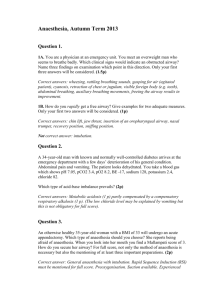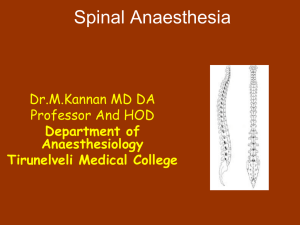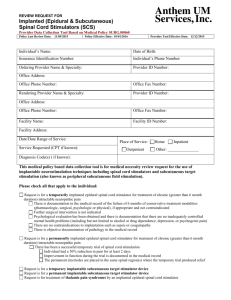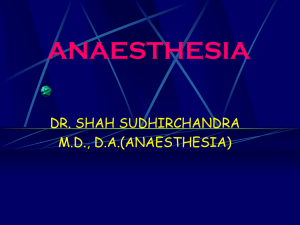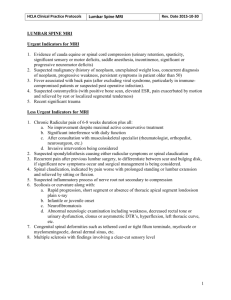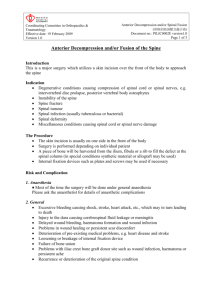a rare case of quadriplegia due to spinal epidural haematoma
advertisement
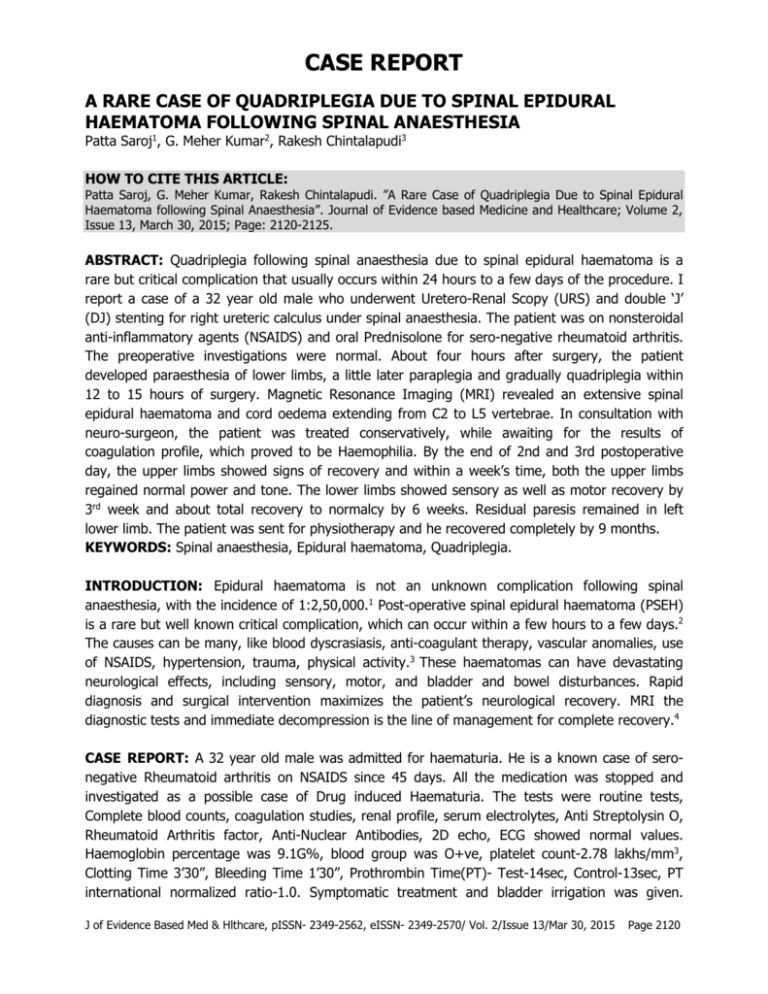
CASE REPORT A RARE CASE OF QUADRIPLEGIA DUE TO SPINAL EPIDURAL HAEMATOMA FOLLOWING SPINAL ANAESTHESIA Patta Saroj1, G. Meher Kumar2, Rakesh Chintalapudi3 HOW TO CITE THIS ARTICLE: Patta Saroj, G. Meher Kumar, Rakesh Chintalapudi. ”A Rare Case of Quadriplegia Due to Spinal Epidural Haematoma following Spinal Anaesthesia”. Journal of Evidence based Medicine and Healthcare; Volume 2, Issue 13, March 30, 2015; Page: 2120-2125. ABSTRACT: Quadriplegia following spinal anaesthesia due to spinal epidural haematoma is a rare but critical complication that usually occurs within 24 hours to a few days of the procedure. I report a case of a 32 year old male who underwent Uretero-Renal Scopy (URS) and double ‘J’ (DJ) stenting for right ureteric calculus under spinal anaesthesia. The patient was on nonsteroidal anti-inflammatory agents (NSAIDS) and oral Prednisolone for sero-negative rheumatoid arthritis. The preoperative investigations were normal. About four hours after surgery, the patient developed paraesthesia of lower limbs, a little later paraplegia and gradually quadriplegia within 12 to 15 hours of surgery. Magnetic Resonance Imaging (MRI) revealed an extensive spinal epidural haematoma and cord oedema extending from C2 to L5 vertebrae. In consultation with neuro-surgeon, the patient was treated conservatively, while awaiting for the results of coagulation profile, which proved to be Haemophilia. By the end of 2nd and 3rd postoperative day, the upper limbs showed signs of recovery and within a week’s time, both the upper limbs regained normal power and tone. The lower limbs showed sensory as well as motor recovery by 3rd week and about total recovery to normalcy by 6 weeks. Residual paresis remained in left lower limb. The patient was sent for physiotherapy and he recovered completely by 9 months. KEYWORDS: Spinal anaesthesia, Epidural haematoma, Quadriplegia. INTRODUCTION: Epidural haematoma is not an unknown complication following spinal anaesthesia, with the incidence of 1:2,50,000.1 Post-operative spinal epidural haematoma (PSEH) is a rare but well known critical complication, which can occur within a few hours to a few days.2 The causes can be many, like blood dyscrasiasis, anti-coagulant therapy, vascular anomalies, use of NSAIDS, hypertension, trauma, physical activity.3 These haematomas can have devastating neurological effects, including sensory, motor, and bladder and bowel disturbances. Rapid diagnosis and surgical intervention maximizes the patient’s neurological recovery. MRI the diagnostic tests and immediate decompression is the line of management for complete recovery.4 CASE REPORT: A 32 year old male was admitted for haematuria. He is a known case of seronegative Rheumatoid arthritis on NSAIDS since 45 days. All the medication was stopped and investigated as a possible case of Drug induced Haematuria. The tests were routine tests, Complete blood counts, coagulation studies, renal profile, serum electrolytes, Anti Streptolysin O, Rheumatoid Arthritis factor, Anti-Nuclear Antibodies, 2D echo, ECG showed normal values. Haemoglobin percentage was 9.1G%, blood group was O+ve, platelet count-2.78 lakhs/mm3, Clotting Time 3’30”, Bleeding Time 1’30”, Prothrombin Time(PT)- Test-14sec, Control-13sec, PT international normalized ratio-1.0. Symptomatic treatment and bladder irrigation was given. J of Evidence Based Med & Hlthcare, pISSN- 2349-2562, eISSN- 2349-2570/ Vol. 2/Issue 13/Mar 30, 2015 Page 2120 CASE REPORT Ultrasound abdomen showed mild hydro-uretero nephrosis on the right side and was diagnosed as Right mid-ureteric Calculus. The case was posted two days later for Right URS (uretero-reno scopy) and double J (DJ) stenting under spinal anaesthesia. OPERATIVE NOTES: Under strict aseptic precautions, spinal anaesthesia was given with 3ml of 0.5% Bupivacaine, using 25G Quinke spinal needle at L3-L4 inter-spinous space in left lateral position. There was difficulty in positioning and after three attempts clear cerebro-spinal fluid was obtained into which Bupivacaine was given. The effect was good and vitals were maintained and the patient was stable throughout the procedure. On passing the scope and examination, there was no calculus except few blood clots coming out of the orifice of the right ureter and the same were removed and D J stent was passed. The duration of the procedure was 45 minutes. Bladder catheterization was done. He had uneventful recovery and was shifted to the ward. POST-OPERATIVE COURSE: After 4 hours after the procedure, he complained of disability to lift the upper and lower limbs and generalized weakness. Pain sensation of both lower limbs was present. After 2hours, (i.e., 6 hours after the procedure) he developed paraplegia and in the next 6 hours, he developed quadriplegia. Magnetic Resonance Imaging (MRI) of whole spine was done.T2 Axial, T2 Whole spine sagittal, T1, IR sequences revealed extensive posterior and anterior haematoma of cervical spine, dorsal spine and lumbar spine and cord edema from C2 – D3 levels. There was abnormal signal, probably soft tissue contusions in posterior paraspinal tissues at L3 and cervical region. In consultation with neuro-surgeon, the patient was treated conservatively with inj. Methylprednisolone, inj. Vitamin K 10mg, inj. Mannitol 100ml IV, 8th hourly, inj. Tranexemic acid. By first post-operative day, motor power in the upper limbs was 1/5 and the lower limbs was 0/5, deep tendon reflexes are flexia, pain sensation was felt in both the lower limbs. There was improvement by third post-operative day in the upper limbs, he was able to lift upper limbs and the motor power was 3/5, but the lower limbs remained paralyzed, pain sensation was present. Fig. 1: MRI showing cord edema at C2 level -sagittal section. Fig. 2: MRI showing cord edema at D3 level- sagittal section. Fig. 1 & 2 J of Evidence Based Med & Hlthcare, pISSN- 2349-2562, eISSN- 2349-2570/ Vol. 2/Issue 13/Mar 30, 2015 Page 2121 CASE REPORT Fig. 3: MRI Lumbar spine haematoma sagittal section. Fig. 4: MRI Lumbar spine haematoma coronal section. Fig. 3 & 4 He was investigated once again and found to have coagulation disorder, Haemophilia. The treatment which was being administered was stopped. He was transfused with fresh blood, packed cells, fresh frozen plasma (FFP). There was gradual recovery to normal of upper limbs in a week’s time and partial recovery of lower limbs by the end of second week. He was sent for physiotherapy for a week. The motor power in the lower limbs was 3/5 and deep tendon reflexes were brisk. Since the patient could not afford, there was some delay in giving Factor VIII. Repeat MRI after 6 weeks showed complete resolution of cervical cord oedema and resolution of haematoma of lumbar region. The double J stent was removed. He was discharged after two months with residual paresis and advised physiotherapy. He recovered completely by nine months. Fig. 5: Repeat MRI showing resolution of cord edema at C2 level-sagittal section. Fig. 6: Repeat MRI showing resolution of cord edema at D3 level- sagittal section. Fig. 5 & 6 J of Evidence Based Med & Hlthcare, pISSN- 2349-2562, eISSN- 2349-2570/ Vol. 2/Issue 13/Mar 30, 2015 Page 2122 CASE REPORT Fig. 7: Repeat MRI showing resolution of cord edema Lumbar level-sagittal section. Fig. 7 DISCUSSION: Incidence of Spinal Epidural Haematoma (SEH) is 1:1,50,000 to 1:2,20,000.2 The reason for SEH associated with neuraxial blockade are mainly coagulation disorders, anticoagulant therapy, pre-operative use of NSAIDS, puncture of prominent epidural venous plexus, anatomic abnormality, traumatic multiple punctures.2,3,5 Postoperative spinal epidural hematoma though rare, is a recorded complication of spinal surgery.2,6 The probable cause of quadriplegia in this case could be puncture of epidural vessel, resulting in slow leak due to hemophilia and also augmented probably by the platelet aggregation inhibition by the long term usage of NSAIDS. Cervical cord oedema at C2 level could probably explained by a minor trauma or bony compression while positioning the patient by flexion of the neck for spinal anaesthesia. Because PSEH usually develops within 24 hours of surgery, careful observation of patient’s neurological status is necessary.2,6 There are studies that show reported cases of delayed post-operative spinal epidural haematoma (PSEH) causing tetraplegia.(Masashi Neo et al. J. Neurosurgery Spine, vol,5: p251-253, Sept. 2006). The treatment of spinal epidural haematoma is immediate decompression or conservative management. The results with immediate decompression are very encouraging, in fact the outcome is usually dramatically complete recovery. Conservative management is considered in cases of coagulation disorders, those showing signs of resolution, transient venous bleed or minimal localized bleed and often the results are of total recovery. The incidence of PSEH requiring evacuation is reported to be 0.1% - 0.2%.2,3 This patient was treated conservatively without surgical intervention because of the extensive posterior and anterior epidural haematoma of 0.4cms to 0.6cms involving the cervical spine to lumbar spine and incidentally a case of coagulation disorder. Kou, et al., reported 12 cases (0.1%) of lumbar PSEHs among 12,000 spinal procedures and demonstrated that the operation’s risk factors were J of Evidence Based Med & Hlthcare, pISSN- 2349-2562, eISSN- 2349-2570/ Vol. 2/Issue 13/Mar 30, 2015 Page 2123 CASE REPORT multilevel procedures and preoperative coagulopathy. The use of preoperative non-steroidal antiinflammatory agents (NSAIDS), Rh-positive blood type, haemoglobin level less than 10G% as in this case are also some of the risk factors for PSEH (study by Awad, et al.). In our case, the patient showed early signs of recovery of both the upper limbs followed by gradual recovery of the lower limbs due to active management with fresh blood and blood products, FFP, Factor VIII, Inj. Vitamin K, antibiotics and physiotherapy. The residual paresis in the lower limbs for some time was due to the persisting neurological deficit due to involvement of those specific neurons. The patient recovered completely by nine months and was able to attend to work.7,8 There are various causes leading to spinal epidural haematoma. They are coagulation disorders which can be congenital (haemophilia) or acquired (anti-coagulant therapy); blood dyscrasiasis; vascular anomalies (arterio-venous malformations-AVM, haemangiomas); Aspirin, NSAIDS preoperative long term usage; neoplasms; lumbar puncture or epidural anaesthesia; traumatic8 (rheumatoid arthritis, Paget’s disease, ankylosing spondylitis). In conclusion, the possibility of delayed PSEH should be kept in mind and observe the patient for 24 to 48 hours post-operatively. In case the patient presents with paresis or paralysis after an operation, prompt diagnosis should be made and treated without delay. MRI plays an important diagnostic role. Early intervention enables full recovery and good clinical outcome which is beneficial both to the clinician and the patient. REFERENCES: 1. Alan & Aitkenhead-Text Book of Anaesthesia, 4th ed.2001. 2. Awad JN, Kebaish KM, Donigan J, Cohen DB, Kostuik JP: Analysis of the risk factors for the development of post-operative spinal epidural haematoma. J Bone Joint Surg Br 87: 12481252, 2005. 3. Kou J, Fischgrund J, Biddinger A, Herkowitz H: Risk factors for spinal epidural haematoma after spinal surgery. Spine 27: 1670-1673, 2002. 4. Holtas S, Heiling M, Lonntoft M. Spontaneous spinal epidural haematoma. Findings at MRI imaging and clinical correlation. Radiology; 199: 409-33, 1996. 5. Boukobza M, Guichand JP, Boissonet M., Spinal epidural haematoma: report of 11 cases and review of the literature. Neuroradiology; 36; 456-459. 1994. 6. Masashi Neo, Takeshi Sakamoto, Shunsuke Fujibayashi, Takashi Nakamura: Delayed postoperative spinal epidural haematoma causing tetraplegia. J Neurosurg Spine, vol 5: 251253, 2006. 7. Emery DJ, Cochrane DD: Spontaneous remission of paralysis due to spinal Extradural haematoma: case report. Neuro surgery 23: 762-764. (1988). 8. Galzio R, Zenobii M, D’Ecclesia G: Spontaneous spinal epidural haematoma: report of a case with complete recovery. Surg Neurol; 14: 263-5. 1980. J of Evidence Based Med & Hlthcare, pISSN- 2349-2562, eISSN- 2349-2570/ Vol. 2/Issue 13/Mar 30, 2015 Page 2124 CASE REPORT AUTHORS: 1. Patta Saroj 2. G. Meher Kumar 3. Rakesh Chintalapudi PARTICULARS OF CONTRIBUTORS: 1. Associate Professor, Department of Anaesthesia, Andhra Medical College, Visakhapatnam. 2. Assistant Professor, Department of Anaesthesia, Andhra Medical College, Visakhapatnam. 3. Assistant Professor, Department of Anaesthesia, Andhra Medical College, Visakhapatnam. NAME ADDRESS EMAIL ID OF THE CORRESPONDING AUTHOR: Dr. Patta Saroj, # 10-4-18, Asilmetta Jn., Visakhapatnam-530003, Andhra Pradesh. E-mail: saroj_patta@yahoo.com Date Date Date Date of of of of Submission: 18/03/2015. Peer Review: 19/03/2015. Acceptance: 23/03/2015. Publishing: 30/03/2015. J of Evidence Based Med & Hlthcare, pISSN- 2349-2562, eISSN- 2349-2570/ Vol. 2/Issue 13/Mar 30, 2015 Page 2125
